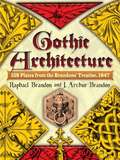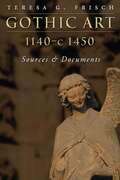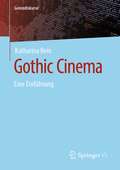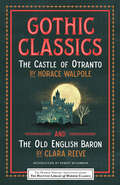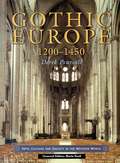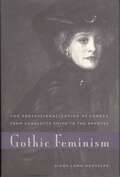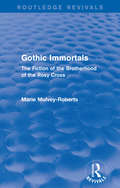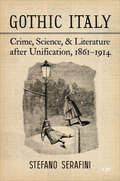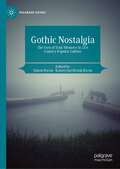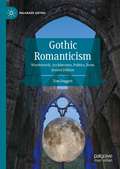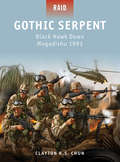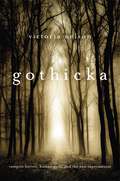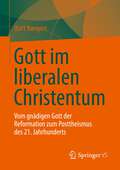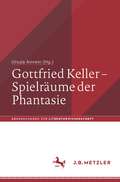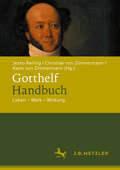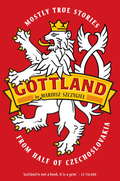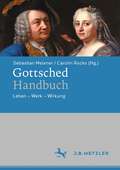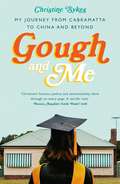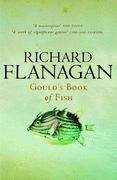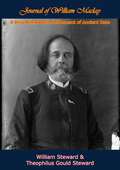- Table View
- List View
Gothic Architecture and Sexuality in the Circle of Horace Walpole
by Matthew M. ReeveGothic Architecture and Sexuality in the Circle of Horace Walpole shows that the Gothic style in architecture and the decorative arts and the tradition of medievalist research associated with Horace Walpole (1717–1797) and his circle cannot be understood independently of their own homoerotic culture. Centered around Walpole’s Gothic villa at Strawberry Hill in Twickenham, Walpole and his “Strawberry Committee” of male friends, designers, and dilettantes invigorated an extraordinary new mode of Gothic design and disseminated it in their own commissions at Old Windsor and Donnington Grove in Berkshire, Lee Priory in Kent, the Vyne in Hampshire, and other sites. Matthew M. Reeve argues that the new “third sex” of homoerotically inclined men and the new “modern styles” that they promoted—including the Gothic style and chinoiserie—were interrelated movements that shaped English modernity. The Gothic style offered the possibility of an alternate aesthetic and gendered order, a queer reversal of the dominant Palladian style of the period. Many of the houses built by Walpole and his circle were understood by commentators to be manifestations of a new queer aesthetic, and in describing them they offered the earliest critiques of what would be called a “queer architecture.” Exposing the role of sexual coteries in the shaping of eighteenth-century English architecture, this book offers a profound and eloquent revision to our understanding of the origins of the Gothic Revival and to medievalism itself. It will be welcomed by architectural historians as well as scholars of medievalism and specialists in queer studies.
Gothic Architecture and Sexuality in the Circle of Horace Walpole (G - Reference, Information And Interdisciplinary Subjects Ser.)
by Matthew M. ReeveGothic Architecture and Sexuality in the Circle of Horace Walpole shows that the Gothic style in architecture and the decorative arts and the tradition of medievalist research associated with Horace Walpole (1717–1797) and his circle cannot be understood independently of their own homoerotic culture. Centered around Walpole’s Gothic villa at Strawberry Hill in Twickenham, Walpole and his "Strawberry Committee" of male friends, designers, and dilettantes invigorated an extraordinary new mode of Gothic design and disseminated it in their own commissions at Old Windsor and Donnington Grove in Berkshire, Lee Priory in Kent, the Vyne in Hampshire, and other sites. Matthew M. Reeve argues that the new "third sex" of homoerotically inclined men and the new "modern styles" that they promoted—including the Gothic style and chinoiserie—were interrelated movements that shaped English modernity. The Gothic style offered the possibility of an alternate aesthetic and gendered order, a queer reversal of the dominant Palladian style of the period. Many of the houses built by Walpole and his circle were understood by commentators to be manifestations of a new queer aesthetic, and in describing them they offered the earliest critiques of what would be called a "queer architecture." Exposing the role of sexual coteries in the shaping of eighteenth-century English architecture, this book offers a profound and eloquent revision to our understanding of the origins of the Gothic Revival and to medievalism itself. It will be welcomed by architectural historians as well as scholars of medievalism and specialists in queer studies.
Gothic Architecture: 158 Plates from the Brandons' Treatise, 1847
by Raphael Brandon J. Arthur BrandonThis comprehensive study of Gothic architecture traces the distinctively beautiful elements of Gothic style through the medieval churches of Europe. Gathered from a rare two-volume Victorian classic, over 700 meticulously rendered details and illustrations display every intricate aspect of Western culture's most magnificent ecclesiastical structures, including London's Westminster Abbey Church. The only edition of these antique architectural plates in print, this splendid book is a one-of-a-kind source of authentic Gothic design.In page after fascinating page, this rich retrospective features the finest examples of medieval masonwork, woodwork, and metalwork dating back to the thirteenth century. Explore the soaring Gothic characteristics of vaulted ceilings, arched windows, flying buttresses, pointed spires, ornamental filials, and decorative panels, plus doorways, moldings, roofing, porches, door hinges, and other elaborate architectural elements.Filled with fascinating insights into the creation of Gothic-style churches and cathedrals, this sweeping survey also provides lively observations of the medieval period.
Gothic Art 1140-c1450: Sources And Documents
by Teresa G. FrischAn anthology offering a chronological assessment of a whole range of technical documents on art written by and for clerks, laymen, churchmen, lawyers, city magistrates, and guilds, this text reveals differences in milieu, customs, resources and psychology during different periods. First Published in 1971 by Prentice Hall.
Gothic Cinema: An introduction
by Katharina ReinGothic Cinema closes a gap in German-language film discourse: for the first time, the volume sheds light on a hitherto little-discussed film context. It considers Gothic Cinema as a form of unofficial historiography that allows a look not only at the history of film and its technique, but also at moral concepts, gender relations, collective fears or aesthetic currents. A delimitation and definition of the term and the central elements of the Gothic are followed by a comprehensive historical overview from 1896 to the present day. Three in-depth analyses of individual post-2015 gothic films and television series round out the review. On the one hand, the examples examined are representative in terms of typical elements, motifs or topoi, and on the other hand, they exhibit peculiarities and breaks that prove fruitful for a cultural and media studies investigation.
Gothic Cinema: Eine Einführung (Genrediskurse)
by Katharina ReinMit Gothic Cinema schließt sich eine Lücke im deutschsprachigen Filmdiskurs: Erstmalig beleuchtet der Band einen bislang wenig diskutierten Filmzusammenhang. Er betrachtet das Gothic Cinema als als eine Form inoffizieller Historiographie, die einen Blick nicht nur auf die Geschichte des Films und seiner Technik, sondern auch auf Moralvorstellungen, Geschlechterverhältnisse, kollektive Ängste oder ästhetische Strömungen zulässt. Auf eine Abgrenzung und Bestimmung des Begriffs und der zentralen Elemente des Gothic folgt ein umfassender historischer Überblick von 1896 bis zur heutigen Zeit. Drei ausführliche Analysen einzelner Gothic-Filme und Fernsehserien nach 2015 runden die Betrachtung ab. Die untersuchten Beispiele sind einerseits repräsentativ im Hinblick auf typische Elemente, Motive oder Topoi und weisen andererseits Besonderheiten und Brüche auf, die sich für eine kultur- und medienwissenschaftliche Untersuchung als fruchtbar erweisen.
Gothic Classics: The Castle of Otranto and The Old English Baron (Haunted Library Horror Classics)
by Horace Walpole Clara ReeveManfred, the lord of the castle of Otranto, has long lived in dread of an ancient prophecy: it's foretold that when his family line ends, the true owner of the castle will appear and claim it. In a desperate bid to keep the castle, Manfred plans to coerce a young woman named Isabella into marrying him.Isabella refuses to yield to Manfred's reprehensible plan. But once she escapes into the depths of the castle, it becomes clear that Manfred isn't the only threat. As Isabelle loses herself in the seemingly endless hallways below, voices reverberate from the walls and specters wander through the dungeons. Otranto appears to be alive, and it's seeking revenge for the sins of the past.
Gothic Europe 1200-1450 (Arts Culture and Society in the Western World)
by Derek PearsallThis uniquely ambitious history offers an account of all aspects of cultural activity and production throughout the world of Latin Christendom 1200-1450. Beginning with a detailed description of the political and economic circumstances that allowed the 'Gothic Moment' to flourish, the body of the book is both a celebration of the Gothic cultural achievement - in cathedral-building, in manuscript illumination, in chivalric love-romance, in stained glass and in many other arts - and an investigation of its social origins and systems of production.
Gothic Feminism: The Professionalization of Gender from Charlotte Smith to the Brontës (G - Reference, Information and Interdisciplinary Subjects)
by Diane Long HoevelerAs British women writers in the late eighteenth and early nineteenth centuries sought to define how they experienced their era's social and economic upheaval, they helped popularize a new style of bourgeois female sensibility. Building on her earlier work in Romantic Androgyny, Diane Long Hoeveler now examines the Gothic novels of Charlotte Smith, Ann Radcliffe, Jane Austen, Charlotte Dacre Byrne, Mary Shelley, and the Brontës to show how these writers helped define femininity for women of the British middle class.Hoeveler argues that a female-created literary ideology, now known as "victim feminism," arose as the Gothic novel helped create a new social role of professional victim for women adjusting to the new bourgeois order. These novels were thinly disguised efforts at propagandizing a new form of conduct for women, teaching that "professional femininity"—a cultivated pose of wise passiveness and controlled emotions—best prepared them for social survival. She examines how representations of both men and women in these novels moved from the purely psychosexual into social and political representations, and how these writers constructed a series of ideologies that would allow their female characters—and readers—fictitious mastery over an oppressive social and political system.Gothic Feminism takes a neo-feminist approach to these women's writings, treating them not as sacred texts but as thesis-driven works that attempted to instruct women in a series of strategic poses. It offers both a new understanding of the genre and a wholly new interpretation of feminism as a literary ideology.
Gothic Immortals (Routledge Revivals): The Fiction of the Brotherhood of the Rosy Cross
by Marie Mulvey-RobertsFirst published in 1990, this book represents the first full-length study of into the group of novels designated ‘Rosicrucian’ and traces the emergence of this distinct fictional genre, revealing a continuous occult tradition running through seemingly diverse literary texts. Taking the Enlightenment as a starting point, the author shows how the physician’s secular appropriation of the idea of eternal life, through the study of longevity and physical decay, attracted writers like William Godwin. It focuses on the bodily immortality of the Rosicrucian hero and investigates the novels of five major writers — Godwin, Percy Bysshe Shelley, Mary Shelley, Maturin, and Bulwer-Lytton.
Gothic Italy: Crime, Science, and Literature after Unification, 1861–1914 (Toronto Italian Studies)
by Stefano SerafiniThe Gothic, proliferating across different literary, socio-cultural, and scientific spaces, permeated and influenced the project of Italian nation-building, casting a dark and pervasive shadow on Italian history. Gothic Italy explores the nuances, contradictions, and implications of the conflict between what the Gothic embodies in post-unification Italy and the values that a supposedly secular, modern country tries to uphold and promote. The book analyses a variety of literary works concerned with crime that tapped into fears relating to contagion, race, and class fluidity; deviant minds and abnormal sexuality; female transgression; male performativity; and the instability of the new body politic. By tracing how writers, scientists, and thinkers engaged with these issues, Gothic Italy unveils the mutual network of exchanges that informed national discourses about crime. Stefano Serafini brings attention to a historical moment that was crucial to the development of modern attitudes towards normality and deviance, which continue to circulate widely and still resonate disturbingly in contemporary society.
Gothic Nostalgia: The Uses of Toxic Memory in 21st Century Popular Culture (Palgrave Gothic)
by Simon Bacon Katarzyna Bronk-BaconThis book is an original and innovative study of how Gothic nostalgia and toxic memory are used to underpin and promote the ongoing culture wars and populist politics in contemporary popular culture. The essays collected here cover topics from the spectral to the ecological, deep fakes to toxic ableism, Mary Poppins to John Wick to reveal how the use of an imaginary past to shape the present, creates truly Gothic times that we can never escape. These ‘hungry ghosts’ from the past find resonance with the Gothic which speaks equally of a past that often not only haunts the present but will not let it escape its grasp. This collection will look at the confluence between various kinds of toxic nostalgia and popular culture to suggest the ways in which contemporary populism has resurrected ideological monsters from the grave to gorge on the present and any possibility of change that the future might represent.
Gothic Romanticism: Wordsworth, Architecture, Politics, Form (Palgrave Gothic)
by Tom DuggettGothic Romanticism: Wordsworth, Architecture, Politics, Form offers a revisionist account of both Wordsworth and the politics of antiquarianism in the late eighteenth and early nineteenth centuries. As a historically-driven study that develops a significant critique and revision of genre- and theory-based approaches to the Gothic, it covers many key works by Wordsworth and his fellow “Lake Poets” Samuel Taylor Coleridge and Robert Southey. The second edition incorporates new materials that develop the argument in new directions opened up by changes in the field over the last decade. The book also provides a sustained reflection upon Romantic conservatism, including the political thought and lasting influence of Edmund Burke. New material places the book in wider and longer context of the political and historical forms seen developing in Wordsworth, and proposes Gothic Romanticism as the alternative line of cultural development to Victorian Medievalism.
Gothic Serpent - Black Hawk Down Mogadishu 1993
by Johnny Shumate Clayton ChunThe United States had demonstrated its military superiority worldwide with its lightning victory over Iraq in 1991. As the only superpower in the world, few would argue that Washington could not prevail in a conventional conflict. Humanitarian missions, however, were another story. Although the United States had experience in a few humanitarian missions, it had just concluded operations in northern Iraq, and was soon to support the United Nations program to help the people in a failed state - Somalia. Somalia was falling apart; it had ceased to exist as a country. Warring tribes had reduced it into an area controlled by warlords. Clan and internecine warfighting had caused major disruption in Somali life. Starvation was a weapon used by the clans. Humanitarian aid and relief arrived but, without security, this support provided little help to the people. On 15 August 1992, President George H.W. Bush ordered military units to airlift supplies into Kenya under Operation Provide Relief. These supplies would enter Somalia with international relief organizations. Still, clans stole the aid for themselves, harassed international relief agencies, extorted money, and allowed starvation to continue. By 8 December, Bush ordered Marines, the US Army's 10th Mountain Division, and Special Forces into Somalia to help UN forces bring order. Some 13,000 American military personnel became part of a security force of 38,000 from UN countries. This massive force helped stabilize Somalia, but the warring factions waited for an opportunity to reassert themselves. By October 1993, the UN security force had shrunk to 16,000, with 4,000 Americans. Two Somali warlords - Muhamed Farrah Aideed and Ali Mahdi Mohamed - had been fighting over control of the capital and main port of Mogadishu. A raid on 3 October, TF Ranger's seventh, aimed at capturing high-ranking Aideed aides initially succeeded with a surprise assault in Mogadishu. While transferring the prisoners to a convoy, Aideed supporters shot down two Army Blackhawk helicopters. These actions resulted in heavy firefights throughout the route of evacuation and the crash sites. The Rangers and others, including two Special Forces snipers who held the second crash site alone, attempted to secure and rescue the downed helicopter crews. The Americans could call on helicopter gunships and had heavy firepower, but against an enemy difficult to identify, in an urban setting, outnumbered, and with darkness approaching, the situation looked grim. The Rangers and Special Forces (Delta Force) fought all night. The10th Mountain Division, Malaysian, and Pakistani forces rescued the Rangers at the first crash site the next day. At the second crash site, Aideed's forces had overwhelmed the area. The two Special Forces snipers died (they received the Congressional Medal of Honor posthumously). In the end, TF Ranger lost 16 killed and 83 wounded. One person died from the relief column. Aideed's force lost 500-1,000 killed and unknown numbers of wounded.
Gothicka
by Victoria NelsonThe Gothic, Romanticism's gritty older sibling, has flourished in myriad permutations since the eighteenth century. In Gothicka, Victoria Nelson identifies the revolutionary turn it has taken in the twenty-first. Today's Gothic has fashioned its monsters into heroes and its devils into angels. It is actively reviving supernaturalism in popular culture, not as an evil dimension divorced from ordinary human existence but as part of our daily lives. To explain this millennial shift away from the traditionally dark Protestant post-Enlightenment Gothic, Nelson studies the complex arena of contemporary Gothic subgenres that take the form of novels, films, and graphic novels. She considers the work of Dan Brown and Stephenie Meyer, graphic novelists Mike Mignola and Garth Ennis, Christian writer William P. Young (author of The Shack), and filmmaker Guillermo del Toro. She considers twentieth-century Gothic masters H. P. Lovecraft, Anne Rice, and Stephen King in light of both their immediate ancestors in the eighteenth century and the original Gothic-the late medieval period from which Horace Walpole and his successors drew their inspiration. Fictions such as the Twilight and Left Behind series do more than follow the conventions of the classic Gothic novel. They are radically reviving and reinventing the transcendental worldview that informed the West's premodern era. As Jesus becomes mortal in The Da Vinci Code and the child Ofelia becomes a goddess in Pan's Labyrinth, Nelson argues that this unprecedented mainstreaming of a spiritually driven supernaturalism is a harbinger of what a post-Christian religion in America might look like.
Gott im liberalen Christentum: Vom gnädigen Gott der Reformation zum Posttheismus des 21. Jahrhunderts
by Kurt BangertDieses Buch bietet in einer durchweg verständlichen Weise einen Gang durch 500 Jahre Theologiegeschichte, von 1520 bis 2020, mit einem besonderen Schwerpunkt auf der Wandlung der Gottesvorstellungen, die anhand der einflussreichsten Philosophen und Theologen exemplifiziert werden. Dabei werden nicht nur die historischen Kontexte der jeweiligen Protagonisten beleuchtet, sondern auch deren Biographien. Ihre theologischen Vorstellungen werden u.a. auch anhand von aussagefähigen Originalzitaten veranschaulicht. Es werden auch das Verhältnis zu anderen Religionen u. das Verhältnis zu den Naturwissenschaften beleuchtet. Das Buch endet mit einem Ausblick auf die zukünftige Theologie.Der AutorKurt Bangert war Forschungsleiter und Research Advisor am World Vision Institut für Forschung und Innovation in Friedrichsdorf. Der Theologe ist Autor zahlreicher Artikel und Bücher sowie Schriftleiter der theologischen Zeitschrift Freies Christentum.
Gottfried Keller – Spielräume der Phantasie (Abhandlungen zur Literaturwissenschaft)
by Ursula AmreinDie in diesem Band versammelten Beiträge zeigen Keller als einzigartigen Erzähler, richten den Blick auf Texte aus dem Nachlass, gehen seinen Träumen und Phantasien nach, verfolgen seine Spuren als Maler, diskutieren seine Theaterprojekte, erläutern seine Beziehung zur Musik und vergegenwärtigen ihn als Politiker. Lektüren, die diesen unterschiedlichen Zusammenhängen Rechnung tragen, bringen pointiert neue Erkenntnisse in die Auseinandersetzung mit Gottfried Keller und seinem Werk ein.
Gotthelf-Handbuch: Leben – Werk – Wirkung
by Jesko Reiling Christian Von Zimmermann Karin Von ZimmermannSeit zwanzig Jahren setzt die Forschung zu Leben, Werk und Wirken von Jeremias Gotthelf neue Akzente. Sie erkundet die innovative Poetik seiner volkspädagogischen Erzählungen als Alternative zu gängigen Traditionen realistischen Erzählens, und sie ersetzt das Bild des Moralpredigers durch jenes eines aufgeklärten und modernen Pfarrers. An die Stelle des reaktionären Bauerndichters tritt das Bild eines Analytikers der ökonomischen und sozialen Bedingungen der Armut. Früh sah Gotthelf die Problemseiten der Industrialisierung und erkannte genauso die Folgen eines Festhaltens an alten Formen des Wirtschaftens. Sein Einsatz für die Schule korrespondierte mit zeitgemäßen pädagogischen Bemühungen; sein publizistisches Wirken diente den Prozessen der politischen Meinungsbildung in einer für ihre Zeit freien republikanischen Gesellschaft. Begriffe wie Freiheit, Gleichheit, Mündigkeit, Fürsorge, Kommunalität und Anthropologie prägen die Gotthelf-Debatten der letzten Jahre. Gotthelfs Werken wird nur ein interdisziplinärer Blick gerecht. Erstmals versucht das Gotthelf-Handbuch diesen Forschungsstand zu sichern und damit zu weiterer Forschung einzuladen.
Gottland
by Antonia Lloyd-Jones Mariusz SzczygielWinner of the Europe Book PrizeOne of Europe's most preeminent investigative journalists travels to the Czech Republic--the Czech half of the former Czechoslovakia, the land that brought us Kafka--to explore the surreal fictions and the extraordinary reality of its twentieth century. For example, there's the story of the small businessman who adopted Henry Ford's ideas on productivity to create the world's largest shoe company--and hired modernist giants such as Le Corbusier to design his company towns (which were also the birthplaces of Ivana Trump and Tom Stoppard). Or the story of Kafka's niece, who loaned her name to writers blacklisted under the Communist regime so they could keep publishing.Or the story of the singer Karel Gott, winner of the country's Best Male Vocalist Award thirty-six years in a row, whose summer home, Gottland, is the Czech Dollywood. Based on meticulous research and hundreds of interviews with everyone from filmmakers to writers to pop stars to ordinary citizens, Gottland is a kaleidoscopic portrait of a resilient people living through difficult and often bizarre times--equally funny, disturbing, stirring and absurd . . . in a word, Kafkaesque.From the Hardcover edition.
Gottlieb's Bakery: Savannah's Sweetest Tradition
by Richard Gottlieb Laurence Gottlieb Michael Gottlieb Isser GottliebIn 1884, in the basement of a building on the corner of York and Jefferson Streets, something miraculous was happening. Jewish Russian immigrant Isadore Gottlieb had built a bakery that would soon be renowned in Savannah for every tasty morsel pulled from its busy oven, creating the perfect combination of southern and Jewish delicacies. Goods were delivered to citizens and stores by cart, pulled by a horse that knew every stop along the way, cementing the bakery's reputation as a true neighborhood operation. From shiny, egg-brushed challah to Sister Sadie's hazelnut cake to the ever-popular chocolate chewies, customers would crowd the store for a single irresistible bite. Join the next generation of Gottliebs as they recount the heartwarming stories and recipes that forever preserve the bakery's place in Savannah's history.
Gottsched-Handbuch: Leben – Werk – Wirkung
by Giulia Morra Bend StrebelJohann Christoph Gottsched (1700–1766) ist eine zentrale Figur der europäischen Aufklärung. Das Handbuch stellt seine Arbeiten in den Bereichen der Poetik, Rhetorik, Philosophie und Sprachforschung dar. Die Poetik erschließt sich mit Blick auf Gattungsdifferenzierungen (Lyrik, Epik, Dramatik, Korrespondenz und Literaturkritik), hinsichtlich einschlägiger poetologischer Traditionslinien (Antike, Französischer Klassizismus, Barock) und in Kollaboration mit anderen Autor*innen, ganz besonders mit Luise Gottsched (1713–1762). Sein Œuvre, dessen Wirkungen und Rezeptionen werden dabei in der Spannung zwischen normpoetischem Anspruch, aufklärerischer Didaxe und proto-ästhetischem Innovationspotenzial diskutiert.
Gough Whitlam: A Moment In History
by Jenny HockingThis moment was not his alone, nor could it ever have come about without him . Gough Whitlam turned to Graham Freudenberg, touched him lightly on the shoulder, saying, 'It's been a long road, Comrade, but we're there', and walked out to meet the spotlight. Acclaimed biographer Jenny Hocking's Gough Whitlam: A Moment in History is the first contemporary and definitive biographical study of the former Labor Prime Minister. From his childhood in the fledging city of Canberra to his first appearance as Prime Minister (playing Neville Chamberlain), to his extensive war service in the Pacific and marriage to Margaret, the champion swimmer and daughter of Justice Wilfred Dovey, the biography draws on previously unseen archival material, extensive interviews with family and colleagues, and exclusive interviews with Gough Whitlam himself. Hocking's narrative skill and scrupulous research reveals an extraordinary and complex man whose life is, in every way, formed by the remarkable events of previous generations of his family, and who would, in turn, change Australian political and cultural developments in the twentieth century.
Gough and Me: My Journey from Cabramatta to China and beyond
by Christine SykesWhen Gough Whitlam moves into her street in Cabramatta in 1957, eight-year-old Christine has little idea how her new neighbour, one of the most visionary and polarising political leaders of Australia, would shape the direction of her life. Born to working-class parents and living in a fibro house built by her truck-driver father, Christine simply dreams that one day she might work as a private secretary like her aunt. But when the reforms Whitlam championed give Christine the chance to go to university, her world expands. She experiences the transformative power of education, struggles to balance motherhood with being the family breadwinner, and faces her own mental health battles. She follows a path forged by Whitlam, from scholarships he fought for, to local community initiatives he generated, and even as far as China, where Whitlam crucially initiated Australia&’s relationship when he visited the country in 1973. Written with genuine heart and humour, Gough and Me is a nostalgic and deeply personal memoir of social mobility, cultural diversity, and the unprecedented opportunities that the Whitlam era gave one Australian working-class woman.
Gould's Book of Fish: A Novel in Twelve Fish
by Richard FlanaganIn 1828, a white convict fell in love with a black woman and discovered that to love is not safe. He is sent to the most feared penal colony and there ordered to paint a book of fish.
Gouldtown: A Very Remarkable Settlement of Ancient Date
by William Steward Theophilus Gould Steward“Studies of Some Sturdy Examples of the Simple Life, Together with Sketches of Early Colonial History of Cumberland County and Southern New Jersey and Some Early Genealogical Records”-Subtitle.Gouldtown, in Cumberland County, New Jersey, has a rare and remarkable history of Free African American success and diversity. In this early-20th century volume, the history and genealogy of the famous Gould family is recounted in exceptional detail.

